Firefighter training ideas for engine company functions
By William Off
Hoseline deployments should be second nature for firefighters, but unfortunately this is not always the case. Perhaps some firefighters have lost a grasp of the basics of hoseline deployments or were never taught properly to begin with. When I became an instructor, my first objective was to teach those basics. We started training by going over the various nozzles my company has on the different apparatus in the station. This is a great review for the firefighters and driver/operators. Please follow all your department’s training guidelines and standard operating guidelines before performing any drills.
- Back to Basics: Pulling the Flat Load Off the Rig
- Smooth Bore vs. Combination…and the Beat Goes On
- The Engine Firefighter: Mastering the Basics
- Improving Preconnect Function and Operation
Hoselines can be preconnected or loaded in static hosebeds. My company has a 100-foot preconnected front bumper line loaded with a 50-foot section for extension. There are three preconnected crosslays. Crosslay number one, colored yellow, is 200 feet of 1 3/4 line with a “low pressure” (50 psi) spin off (detachable) fog nozzle with an integral 7/8-inch smooth bore tip. Crosslay number two, colored red, is 200 feet of 2-inch line hose with a 7/8-inch smooth bore nozzle. Crosslay number three is a green line of two- and half-inch line with a smooth bore nozzle with a 7/8-inch tip. Having different colored hose helps the firefighter know which hoseline to pull and helps the member then inform the operator what line to charge. The nozzlemen can simply say the color, size, or crosslay number to the operator. This also helps the operator know pump pressures to each line.

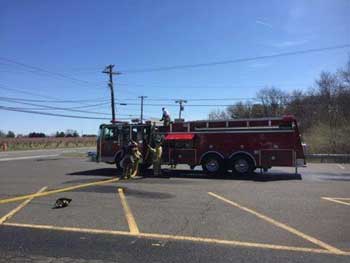
The style of hoselay is also an important piece of information for the firefighter. Different hoselays all deploy in their own way. Our crosslays use the tri-fold lay. After researching various ways to deploy, we concluded there are two different ways we can use depending on the situation. The first is a single firefighter deployment at a straight right angle to the side of the apparatus. (Photos 1 and 2.) Another deployment is necessary if the engine has to leave the front of the fire building open for the ladder company. If this is the case, try to have the driver/engineer line up the crosslays in the space between houses. This gives the firefighter room to deploy the line straight off into that space. If the area of the call is blocked by cars or fences, the tri-fold deployment can be split and pulled off sideways with two firefighters or the operator and a firefighter; a “close quarters” maneuver. (Photos 3 and 4.)
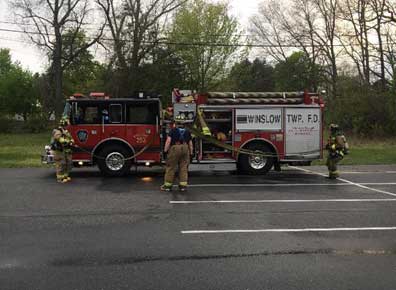
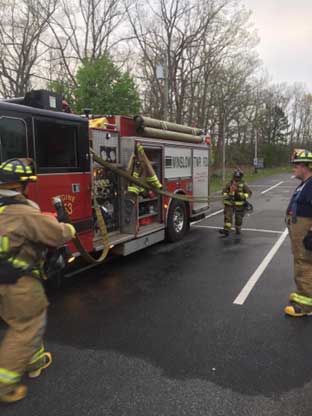
Practice hoseline deployments so that each firefighter can perform them and re-rack them efficiently on and off the engine. Always be sure to clear the bed of all the hose.
In the drills, time each task as your firefighters progress; speed and efficiency will come as skills are improved. While the nozzle firefighter is stretching to the door of the fire building, the irons or backup firefighter is forcing and controlling the door; keeping it close until the line is charged and ready to advance to facilitate a smooth advance with limited number of personnel, bring the first 50-foot coupling of hose up to and parallel to the section connected to the nozzle . For our area, the houses are smaller, and 100 feet would be too much. Once the hoseline is in position, the nozzleman and backup firefighter will don their SCBA face pieces (Photo 5), bleed the air out of the line, and check the pattern and distance. At this point of the drill, they would enter the doorway. (Photo 6.)

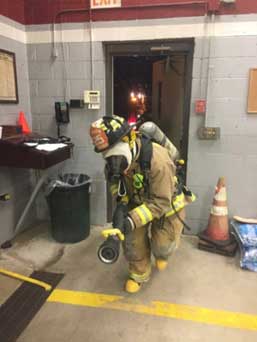

This drill can be performed in a parking lot, inside the door to your bay, or an acquired structure. As the firefighters progress, make adjustments and correct mistakes. When crews become proficient in hose management, incorporate the thermal camera into the drill. In a smoke condition, the thermal camera can be teamed up with the nozzle firefighter to locate the fire and hit the fire. Have the irons/back up firefighter get behind the nozzle firefighter and hold the camera in front of his mask. (Photo 7.)
Once they enter the building, set up obstacles for them to maneuver the hoseline around. Once the crew makes it to the fire room, have the irons firefighter perform a quick search of the room. This member must determine whether there is a window to vent then give the nozzleman the okay to extinguish the fire. Once the nozzleman is hitting the fire, then the irons will take out the window for hydraulic ventilation.
- Hoseline Selection: 1¾- and 2½-Inch Hoselines
- Extending the Hoseline: Overcoming a Short Stretch, Part 1 | Part 2
- Engine Company Basics: The ‘Minuteman’ Hose Load
- Safety, Accuracy, SPEED: The Forging of a Fireground Culture
As the crew becomes more efficient, add more tasks. One example is radio communication to the incident commander (IC). Decide which firefighter of the crew will make the transmissions and make CAN (Conditions, Actions, Needs) reports. Notify the IC that the fire has been located, then notify the IC after extinguishment and that overhaul will begin. Give updates of what is happening in the inside.
We also added water supply to the drill, using a hydrant, tender, and manifold operations. You can have the crew perform their own water supply or have another company in your department assist with the drill with their apparatus.
This goal of these evolutions is to develop a fast and effective crew. Anyone or team that is the best at what they do became that way because of practice. When I played football, we practiced all the basic skills every day of the week. The many hours of studying, weightlifting, and practices were all for that one game, which only lasted about an hour. If you use the same mentality that the fire call is the game, then get yourself ready by being prepared and honing your craft. One key factor of this drill is to find the strengths of your crew. Give them the tools they need to do the job. Allow the crews to develop working as a team. Let them decide what techniques they want to use for each hoseline deployment. This will instill team-building concepts into your drill so that members will naturally operate as a team without any coaching from the instructor.
Top Free Firefighter Training Resources for Fire Instructors
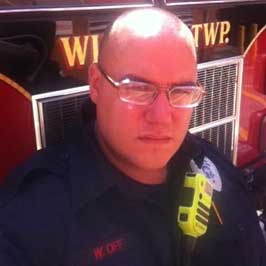
William Off has been in the fire service for more than 15 years and works as a nurse at Virtua Mt. Holly Rehab. He began his career with the Hammonton (NJ) Fire Department and is a firefighter with Winslow Township Fire Department and Winslow Office of Emergency Management (OEM). He has served as an emergency medical technician in Atlantic City, New Jersey, and in addition to his New Jersey practical nursing license holds a number of certifications in fire, EMS, and OEM.

